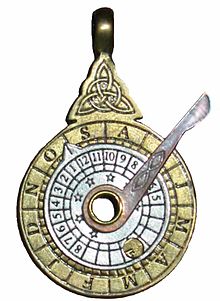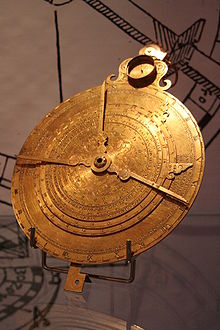- Nocturnal (instrument)
-
 A nocturnal as costume jewellery. This is a functioning nocturnal, though only about 5 cm tall. It shows the month ring on the outside in brass. The silver coloured inner disk shows the time and has an indicator on one edge. By setting the indicator to the month and day (in this case a few days into October), centring Polaris in the hole in the middle and rotating the pointer attached to the centre to a specified circumpolar star, the arm indicates the time (in this case, 8 pm)
A nocturnal as costume jewellery. This is a functioning nocturnal, though only about 5 cm tall. It shows the month ring on the outside in brass. The silver coloured inner disk shows the time and has an indicator on one edge. By setting the indicator to the month and day (in this case a few days into October), centring Polaris in the hole in the middle and rotating the pointer attached to the centre to a specified circumpolar star, the arm indicates the time (in this case, 8 pm)
A nocturnal is an instrument used to determine the time based on the position of a certain star in the night sky. Sometimes called a "horologium nocturnum" (time instrument for night) or nocturlabe (in French and occasionally used by English writers), it is closely related to the sun dial. A nocturnal is typically a navigational instrument. Knowing the time is important in piloting for calculating tides and some nocturnals incorporate tide charts for important ports.
The nocturnal was first mentioned by Martín Cortés de Albacar[1] in his Arte de Navegar, published in 1551.[2][3]
The first known description of the instrument was done by Ramon Llull by the end of the thirteenth century in his book Opera Omnia upon the names of astrolabium nocturnum and sphæra horarum noctis.[4]
Contents
Construction
Nocturnals have been most commonly constructed of wood or brass.
A nocturnal will have an outer disc marked with the months of the year, and an inner disc marked with hours (and perhaps half hours) as well as locations for one or more reference stars. It will also have a pointer rotating on the same axis as the discs. The axis, or pivot point, must be such that a star can be sighted through it; usually a hollow rivet is used. Since the instrument is used at night, markings may be exaggerated or raised. Often the inner disc has a diagram of the necessary constellations and stars, to aid in locating them.
Usage
In the northern hemisphere, all stars will appear to rotate about the North Star (known as Polaris) during the night, and their positions, like the progress of the sun, can be used to determine the time. The positions of the stars will change based on the time of year. A nocturnal is a simple analog computer, made of several dials, that will provide the time of day based on a time of year and a sighting of Polaris and some other common star.
The most commonly used reference stars are the pointer stars from the Big Dipper (Ursa Major) or Kochab from the Little Dipper (Ursa Minor). The star Shedar in Cassiopeia may also be used, since it is on the opposite side of the sky from Ursa Major.
The inner disc is rotated so that the mark for the chosen reference star points to the current date on the outer disc. The north star is sighted through the center of the device, and the pointer arm is rotated to point at the chosen reference star. The intersection of the pointer arm with the hour markings on the inner disc indicates the time. The instrument must be held upright, and should have a handle or similar hint as to which direction is down.
See also
References
- ^ See es:Martín Cortés de Albacar for the Spanish Wikipedia biography
- ^ Harriet Wynter and Anthony Turner, Scientific Instruments, Studio Vista, 1975, ISBN 0-289-70403-0
- ^ There may be an earlier date - It was described ca. 1530 by Peter Apianus in his "Cosmographicus Liber" republished later by Gemma Frisius with a widely circulated illustration of the instrument while being used by an observer. The earliest origins of the instrument are currently under investigation by P.C.F., the author of this footnote
- ^ An analysis of navigational instruments in the age of exploration : 15th century to mid-17th century - Master of art thesis by Lois Ann Swanick, Texas A&M University page=106.
External links
- British Museum – Nocturnal from an astrological compendium
- Simulation – Video and description, also, lots of devices
- A working nocturnal in coin form
Categories:- Navigational equipment
- Astronomical instruments
- Historical scientific instruments
Wikimedia Foundation. 2010.

